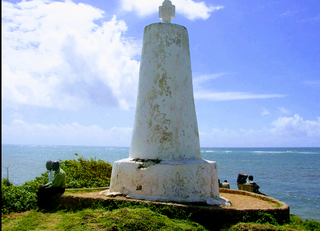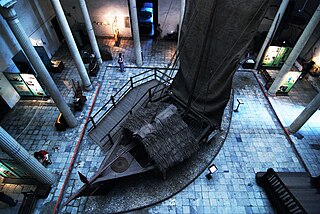The Takwa settlement is situated on the south side of Manda Island, in the Lamu District in the coastal province of Kenya. They are the ruins of a town which was abandoned around the 18th century.
The Takwa site can be easily reached from Lamu town. The ruins were first excavated by James Kirkman in 1951. In 1972 the site was cleared again under the supervision of James de Vere Allen, the Curator of the Lamu Museum.
Takwa was never a large place. It was founded around 1500, and probably abandoned around 1700. Kirkman thought that it was perhaps a place where holy men or religious people retreated. The Great Mosque at Takwa is relatively well preserved. The other structure of importance is the Pillar Tomb, which has an inscription with the date of 1681–1682. It is reported that when Takwa was abandoned, its inhabitants settled just across the bay at Shela on Lamu Island. Twice a year the people of Shela come to the Pillar Tomb in Takwa to pray for rain. [1] The Takwa Ruins were designated a Kenyan National Monument in 1982.

Malindi is a town on Malindi Bay at the mouth of the Sabaki River, lying on the Indian Ocean coast of Kenya. It is 120 kilometres northeast of Mombasa. The population of Malindi was 119,859 as of the 2019 census. It is the largest urban centre in Kilifi County.

The ruins of Gedi are a historical and archaeological site near the Indian Ocean coast of eastern Kenya. The site is adjacent to the town of Gedi in the Kilifi District and within the Arabuko-Sokoke Forest.

Kilwa Kisiwani is an island, national historic site, and hamlet community located in the township of Kilwa Masoko, the district seat of Kilwa District in the Tanzanian region of Lindi Region in southern Tanzania. Kilwa Kisiwani is the largest of the nine hamlets in the town Kilwa Masoko and is also the least populated hamlet in the township with less than 1,000 residents. At its peak Kilwa hosted over 10,000 inhabitants in the Middle Ages. Since 1981 the entire island of Kilwa Kisiwani has been designated by UNESCO as a World Heritage Site along with the nearby ruins of Songo Mnara. Despite its significant historic reputation, Kilwa Kisiwani is still home to a small and resilient community of native residents that have inhabited the island for centuries. Kilwa Kisiwani is one of the seven World Heritage Sites located in Tanzania.
The Swahili people comprise Afro-Arab, Bantu and Comorian ethnic groups inhabiting the Swahili coast, an area encompassing the Zanzibar archipelago and mainland Tanzania's seaboard, littoral Kenya, northern Mozambique, the Comoros Islands, southwestern Somalia and Northwest Madagascar. The original Swahili distinguish themselves from other Bantu peoples by self-identifying as either 'Arab' or Waungwana. In certain regions this differentiation is even more stratified in terms of societal grouping and dialect, hinting to the historical processes by which the Swahili have coalesced over time. More recently however, Swahili identity extends to any person of African descent who speaks Swahili as their first language, is Muslim and lives in a town on the main urban centers of most of modern day Tanzania and coastal Kenya, northern Mozambique and the Comoros, through a process of swahilization.

Lamu or Lamu Town is a small town on Lamu Island, which in turn is a part of the Lamu Archipelago in Kenya. Situated 341 kilometres (212 mi) by road northeast of Mombasa that ends at Mokowe Jetty, from where the sea channel has to be crossed to reach Lamu Island. It is the headquarters of Lamu County and a UNESCO World Heritage Site.

Pate (Paté) Island is located in the Indian Ocean close to the northern coast of Kenya, to which it belongs. It is the largest island in the Lamu Archipelago, which lie between the towns of Lamu and Kiunga in the former Coast Province. The island is almost completely surrounded by mangroves.

The Lamu Archipelago is located in the Indian Ocean close to the northern coast of Kenya, to which it belongs. The islands lie between the towns of Lamu and Kiunga, near the Coast Province. It is a part of Lamu District.

Gede is a village on the Indian Ocean coast of Kenya, lying in Kilifi County, south of Malindi and north of Watamu. The Ruins of Gedi are located there. Although not thought to be mentioned in historic sources, extensive ruins of a former port have been dated to the thirteenth century or earlier, including a tomb with a date corresponding to 1399, until at least the seventeenth century. Later, the port was abandoned and not rediscovered until the 1920s.

Manda is an island of the Lamu Archipelago of Kenya, known for the prosperous 9th century ports of Takwa and Manda town. The island is now linked by ferry to Lamu and is home to Manda Airport, while Manda Toto island lies to its west. The island is separated from the mainland by the narrow Mkanda channel.

Lamu Island is a port, city, and island just off the shore of Kenya in the Indian Ocean approximately 150 miles from Mombasa. It is a part of the East African country of Kenya. Lamu was founded in the 12th Century. Lamu is one of the longest established, and best preserved remaining settlements of the Swahili tradition in east Africa that remains today. The island has continually been inhabited for over seven hundred years, and continues to be an important center in eastern Africa.

Swahili architecture is a term used to designate a whole range of diverse building traditions practiced or once practiced along the eastern and southeastern coasts of Africa. Rather than simple derivatives of Islamic architecture from the Arabic world, Swahili stone architecture is a distinct local product as a result of evolving social and religious traditions, environmental changes, and urban development.

Aluka was an online digital library focusing on materials about Africa. Aluka's mission is to connect scholars from around the world by building a common platform that allows online collaboration and knowledge sharing. Aluka's audience is higher education and research communities worldwide.

The Zamani Project is part of the African Cultural Heritage Sites and Landscapes Database. Zamani is a research group at the University of Cape Town, which acquires, models, presents and manages spatial and other data from cultural heritage sites. The present focus of the Zamani project is Africa, with the principal objective of developing “The African Cultural Heritage Sites and Landscapes Database”. Zamani comes from the Swahili phrase “Hapo zamani za kale” which means “Once upon a time”, and can be used to mean 'the past'. The word is derived from Arabic root for temporal vocabulary, ‘Zaman,’ and appears in several languages around the world.

The mtepe is a boat associated with the Swahili people. The mtepe's planks are held together by wooden pegs and coir, so it is a sewn boat designed to be flexible in contrast to the rigid vessels of western technique.
Faza is a small town on the North coast on Pate Island, within the Lamu Archipelago in Kenya's former Coast Province.

Siyu is a settlement on the north coast of Pate Island, within the Lamu Archipelago in Kenya's Coast Province.

Lamu Fort is a fortress in the town of Lamu in northeastern Kenya. Originally situated on the waterfront, the fort today is located in a central position in the town, about 70 metres (230 ft) from the main jetty on the shore.
The Battle of Shela occurred around 1812 on the sand dunes near the village of Shela on Lamu Island, in what is now Kenya, just south of the larger village of Lamu. The people of Lamu won against superior forces from Mombasa and Pate. The battle led to the domination of the coast by the rulers of Oman.
Shanga is an archaeological site located in Pate Island off the Eastern Coast of Africa. The site covers about 15 hectares. Shanga was excavated during an eight-year period in which archaeologists examined Swahili origins. The archaeological evidence in the form of coins, pottery, glass and beads all suggest that a Swahili community inhabited the area during the eighth century. Evidence from the findings also indicates that the site was a Muslim trading community that had networks in Asia.

Pemba Island is a small island off the coast of Tanzania. Inhabited since 600 AD, the island has a trading, agricultural, and religious history that has contributed to the studies of the Swahili Coast trade throughout the Indian Ocean.
| Wikimedia Commons has media related to Takwa . |
Coordinates: 2°17′54.55″S40°57′30.32″E / 2.2984861°S 40.9584222°E